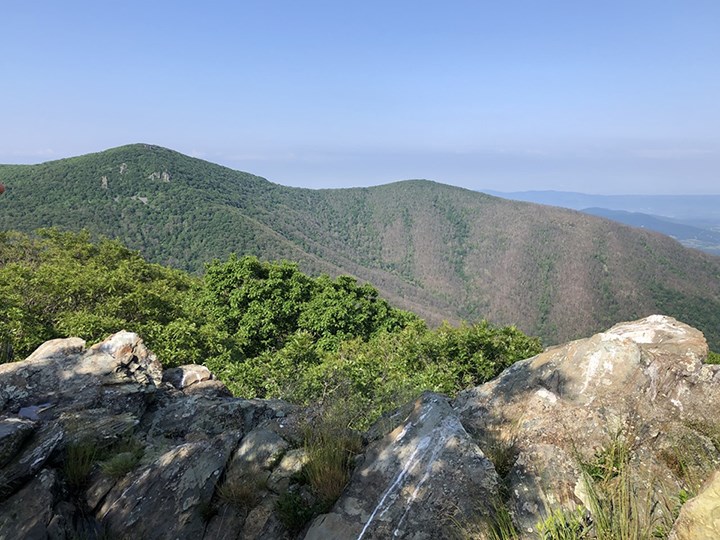
NPS Photo Spongy Moth Treatment FAQs Once the date of treatment is known, information will be posted on the park’s website and social media, a notice will be sent via the park’s alert system, signage will be posted throughout the park, notices will be distributed at the entrance stations, and on the day of spraying Rangers will rove the affected areas to keep visitors informed.
Text SHENALERTS to 888777 to receive alerts. You can opt-out at any time and will only receive alerts about important information that may impact your visit.
The goal of the treatment is to suppress spongy moth populations to prevent tree mortality. The chances that trees die from spongy moth defoliation go up dramatically when they are defoliated for multiple years in a row. Dead trees in high visitor use areas create safety hazards and can threaten historic buildings, and the primary goal of the treatment is to prevent tree mortality in these areas.
The spray will contain BtK (Bacillus thuringiensis Kurstaki), which has been thoroughly studied and is used extensively in agriculture and in other applications. It has been repeatedly shown that exposure is safe for humans, wildlife, plants, buildings, and vehicles.
Although the spray is not harmful, it will come in the form of a light mist that may leave residue on clothing, cars and tents, and the helicopter doing the spraying will be loud, so visitors may want to avoid active treatment areas.
Pay close attention to the information being shared before and during your visit. If you are in the park on the days of treatment, avoid the treatment areas (see map).
If the helicopter passes over you while spraying, you will simply feel a light mist. It is not harmful and can be cleaned with soap and water.
Any residue is not harmful and can be wiped off with soap and water.
For the treatment to be effective, it must occur when caterpillars have hatched but are in the early stages of development. The target timeframe was selected to maximize the effectiveness based on historical timing of caterpillar emergence.
Areas were primarily selected to reduce the development of hazard trees in high visitor use areas that have been defoliated in recent years. Adjacent areas containing sensitive wildlife habitats were added to the treatment area to maintain forest health.
The spongy moth (Lymantria dispar) is a non-native, invasive insect whose larvae (caterpillars) are capable of defoliating large swaths of hardwood forests, primarily targeting oak trees. Such defoliation events are stressful for the affected trees, which can negatively impact growth and ultimately cause mortality. In turn, the mortality of forest trees can cause negative environmental impacts such as habitat loss and degradation, temperature and humidity changes, and colonization by invasive species, in addition to increased human safety risks associated with hazardous dead trees and limbs. Additionally, areas that experience successive years of moderate to severe defoliation are more likely to see high rates of tree mortality.
Spongy moth outbreaks are largely dependent on dry spring conditions. Dry spring conditions are problematic because this suppresses their primary fungal pathogen (Entomophaga maimaiga). Favorable warm, dry conditions in the springs of 2022 and 2023 allowed spongy moth populations to explode and defoliate approximately 9,400 and then 17,000 acres in the Park's Central District, respectively. Much of the defoliation was severe, with trees being completely denuded over large areas, including in designated wilderness.
BtK (Bacillus thuringiensis Kurstaki) is a naturally occurring bacteria. It commonly occurs in soils and on plants throughout the world. It is employed as a biological insecticide used to eradicate the spongy moth. Spongy moth was first detected in Shenandoah National Park in 1982, and since 1986 pesticide applications (mainly BtK) have been used by the park as a management tool to reduce spongy moth populations as needed.
BtK may affect a very low percentage of butterflies and moths that are in their early caterpillar stage and actively feeding during the treatment. The level of BtK in the atmosphere decreases to extremely low levels within an hour after an aerial application. Sunlight and microbes destroy BtK applied to foliage within seven days rendering it ineffective. Most of Shenandoah's butterflies/moths, including monarch butterflies, are not in the caterpillar stage until over a month after the application, when the BtK protein has already degraded. The BtK product does not contaminate the area and does not multiply or accumulate on foliage after it is applied. Furthermore, only small parts of the forest are treated. Butterflies and moths outside the impacted areas are unaffected.
Most BtK applications are applied from aircraft to areas where spongy moths threaten trees and the public. In Shenandoah, aerial (helicopter) spraying will occur in mid-May, when caterpillars are very small (the size of an eyelash) and most susceptible to BtK. This spongy moth spray treatment is intended to reduce defoliation, protect targeted natural resources, and reduce hazard tree development.
There will be noise and possible wind from the low-flying helicopter.

|
Last updated: May 11, 2024
